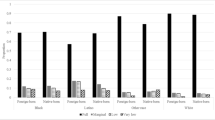Abstract
The purpose of this study was to determine levels of food security among American Indians (AI) living in the Midwest and possible correlations between food security levels and various health outcomes, diet, and demographic variables. This study used a cross-sectional design to determine health behaviors among AI. Participants (n = 362) were recruited by AI staff through various cultural community events in the Midwest, such as powwows and health fairs. Inclusion criteria included the following: age 18 years or older, self-identify as an AI, and willing to participate in the survey. Of all participants, 210 (58%) had either low or very low food security, with 96 in the very low category (26.5%). Participants with very low food security tended to have significantly more chronic conditions. Additional significant differences for very low food security existed by demographic variables, including having no insurance (p < 0.0001) or having a regular primary care provider (p = 0.0354). There was also a significant difference between food security levels and the consumption of fast food within the past week (p value = 0.0420), though no differences were found in fruit and vegetable consumption. AI in our sample had higher levels of food insecurity than those reported in the literature for other racial/ethnic groups. AI and non-Native health professionals should be aware of the gravity of food insecurity and the impact it has on overall health. Additional research is needed to determine specific aspects of food insecurity affecting different Native communities to develop appropriate interventions.
Similar content being viewed by others
References
Pinstrup-Andersen, P. (2009). Food security: Definition and measurement. Food Security, 1(1), 5–7.
Seligman, H. K., Laraia, B. A., & Kushel, M. B. (2010). Food insecurity is associated with chronic disease among low-income NHANES participants. The Journal of Nutrition, 140(2), 304–310.
Blue, B., Jernigan, V., Wetherill, M. S., Hearod, J., et al. (2017). Food insecurity and chronic diseases among American Indians in rural Oklahoma: The THRIVE study. American Journal of Public Health, 107(3), 441–446.
Bauer, K. W., Widome, R., Himes, J. H., et al. (2012). High food insecurity and its correlates among families living on a rural American Indian Reservation. American Journal of Public Health, 102(7), 1346–1352.
Gundersen, C., & Kreider, B. (2009). Bounding the effects of food insecurity on children’s health outcomes. Journal of Health Economics, 28(5), 971–983.
Gundersen, C. (2009). Measuring the extent, depth, and severity of food insecurity: An application to American Indians in the USA. Journal of Population Economics, 21(1), 191–215.
USDA, & USDOA. (2015). Economic research service: Food security in the U.S. key statistics and graphics. Washington, DC: USDA, and USDOA
NRC. (2006). Food insecurity and hunger in the United States: An assessment of the measure. Washington, DC: The National Academies Press
Gorton, D., Bullen, C. R., & Mhurchu, C. N. (2010). Environmental Influences on food secuirty in high-income countries. Nutrition Reviews, 68, 1–29
O’Connell, M., Buchwald, D. S., & Duncan, G. E. (2011). Food access and cost in American Indian communities in Washington State. Journal of The American Dietetic Association, 111(9), 1375–1379.
Nord, M., & Prell, M. (2007) Struggling to feed the family: What does it mean to be food insecure? Retrieved from https://www.ers.usda.gov/amber-waves/2007/june/struggling-to-feed-the-family-what-does-it-mean-to-be-food-insecure/. Accessed 24 July 2017.
NCAI Policy Research Center, & NCOAI. (2012). Demographic profile of Indian Country. Washington, DC: NCAI Policy Research Center and NCOAI
USDA, & USDOA. (2012). U.S. household food security survey module: Six-item short form. Washington, DC: USDA and USDOA
IHS. (2010). Special diabetes program for Indians toolkits. Retrieved from https://www.ihs.gov/sdpi/sdpi-toolkits/diabetes-prevention-program-toolkit/appendices/. Accessed 24 July 2017.
Acknowledgements
The authors would like to thank the reservation and urban American Indian communities who participated in this study.
Funding
This project was supported by the National Cancer Institute at NIH (R24 MD 002773). Additional support was provided by National Institutes of Health (P20 MD 004805).
Author information
Authors and Affiliations
Corresponding author
Ethics declarations
Conflict of interest
The authors declare that they have no conflict of interest.
Rights and permissions
About this article
Cite this article
Berryhill, K., Hale, J., Chase, B. et al. Food Security and Diet Among American Indians in the Midwest. J Community Health 43, 901–907 (2018). https://doi.org/10.1007/s10900-018-0501-5
Published:
Issue Date:
DOI: https://doi.org/10.1007/s10900-018-0501-5




